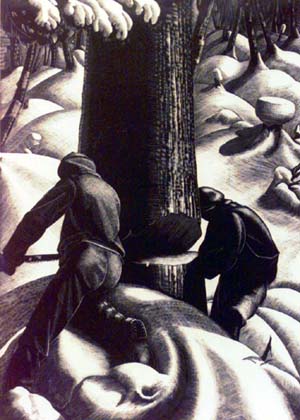
Cutting, 1931
woodcut, 11 1/2 by 8 inches
Illinois State Museum collection
Cutting is one of a series of woodcuts Clare Leighton made about a lumber camp. Here two men use a two-handed crosscut saw to fell an evergreen tree, much like settlers did in Illinois to cut trees for building in the nineteenth century.
Art critics labeled her a regionalist (artist who depicted rural life of his/her area of the country). This art movement was popular in the United States in the 1920s and 1930s. She was not a regionalist by geography, but by subject matter. Other regionalists, such as Grant Wood in the Midwest and Paul Landacre in California, also made the rural life their main subject. More Illinois State Museum artworks with a regionalist flavor and a 1930's Art Deco style can be seen in Depression Era Art in the Art module.
Clare
Leighton
Clare
Leighton was a British-American artist and writer, born in London. She
attended the Slade School of Fine Art and the University of London. She
wrote fifteen books and illustrated 49 others. She grew up in a household
where her father wrote more than 50 books, and the family entertained writers
and intellectuals.
Leighton moved to the United States about 1930, when she came for a book tour and decided to stay. She spent most of her career in Connecticut. Her first book was called The Farmer's Year. It contained text and wood engravings that complemented each other. She often chose country life as her subject matter. Other books she wrote and illustrated were titled Four Hedges and Growing New Roots.
Wood Engraving
A woodcut
is a printing process. To make this woodcut, the artist cut a design into
a flat block of wood. The parts of the design that were not carved away
received ink. Leighton cut away large areas of wood to create the snow
drifts. A printing press pressed the inked block onto paper.